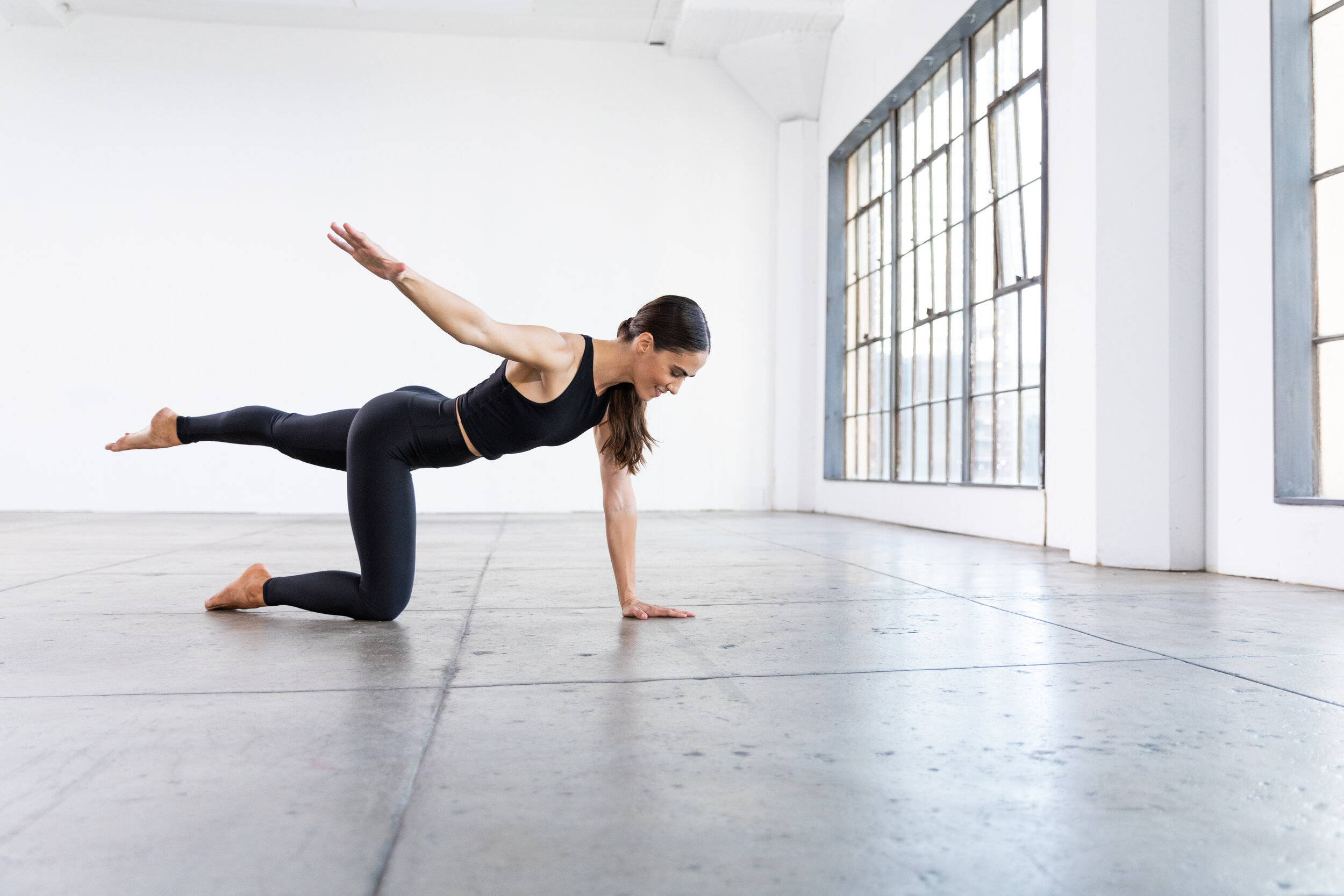The Beginner's Guide to Barre
By now you’ve surely heard of Barre, or maybe have even tried out a class. Over the last decade, Barre has exploded in popularity — and as a fairly accessible workout with a ton of benefits, it won’t be going away any time soon. If you’re new to Barre, we’ve created this guide with you in mind with tips from Alo Moves barre instructor Emily Sferra. Read on to learn more about this lengthening and strengthening workout.
What Is Barre?
Barre is a type of exercise that blends elements of ballet, yoga, strength training, and Pilates into a single, rigorous workout. It tests and builds your strength and endurance, focusing on small, isometric movements that often test under-utilized muscles and lead to a great burn (and oftentimes shaking!).
What to Expect in a Barre Class
Depending on the focus of your Barre class it may look different, but here’s a template to give you an idea. First you’ll do a warm-up, then you may head to the bar (or use your chair or stool) for leg and glute-focused work. Afterwards, you may head to the mat for targeted core work, then incorporate weights or blocks for additional strengthening and toning. Class usually ends with a stretchy, yoga-inspired cool-down.
Benefits of Barre
Increases flexibility
Improves focus
Is a low-impact exercise
Builds total-body strength and endurance
Improves posture and balance
May increase bone density
Reduced stress
Increased muscle definition
According to Sferra, barre work can help improve your overall fitness and performance. “Some of the benefits you can expect of a Barre workout would include the opportunity to build long, lean muscle mass, as well as an improved sense of stability, balance, and general proprioception,” says Sferra.
What to Wear to Barre Class
You’ll want to reach for comfortable, breathable clothing that’s easy to move in for your Barre class. We love the Barre Long Sleeve Top to wear over a bra, or the Airlift Barre Bodysuit. Once you get properly warmed up, you can peel off the long-sleeve top and its cozy fabric can easily take you from your workout to your errands after. The High-Waist Airlift Legging is a smooth, lightweight pick that wicks away moisture and allows you to move freely.
Another great pick is the Amplify Seamless Muscle Tank. It has a stretchy fabric and slim fit that keeps the fabric close to your body and the sweat off as you move. Pair it with the Unity 2-in-1 Short that comes with a compression layer so you can move freely and zip pockets that will keep all of your important items nearby without falling out mid-practice.
Lastly, we recommend the Pivot Barre Sock to help you grip the mat and provide a bit of stability and cushioning to the soles of your feet, though you may prefer to go barefoot.
Barre Class Equipment
Apart from appropriate workout clothes that will facilitate movement, we also recommend a high-quality yoga mat for Barre classes, like the Alo Yoga Warrior Mat, as you’ll utilize one in nearly every class featured on Alo Moves. We also recommend having a block or two, like the Uplifting Yoga Block, so you don’t have to rely on searching for household props. Other props used in Barre classes include small and large inflatable stability balls, sliders, bands, and weights.
Do You Have to Be Flexible to
Do Barre?
No, you do not have to be flexible to do Barre, but you will notice the longer your practice, the more flexible you’ll become.
“Flexibility is not a requirement for a barre workout,” says Sferra. “What you will notice is we focus on the general sense of lengthening within your body throughout the workout.”
Do You Have to Use Weights for Barre Workouts?
No, you do not have to use weights to practice barre. You can opt to use your own body weight, or swap in a household prop substitute if you don’t own a set of weights.
“Most of the workouts can be done without weights, especially if you're just getting started,” says Sferra. “What the weights can do is provide a nice ramp up and add some challenge so you can keep revisiting the same workouts and keep adding heavier weight as you go.”
Do I Need a Ballet Barre for at Home Barre Workouts?
You do not not need a ballet barre for at home workouts. For classes that do require a steady surface, you can substitute the bar with items like a stool, counter, chair, or wall.
Tips for Beginners, from a Barre Instructor
Here are Emily’s top three tips for those new to Barre:
Pace yourself.
You might find that doing half the workout and then returning to the other half later on in the day or the next day works really well for you.Slow down.
If you feel like the tempo is going too fast for your body, trust your body and slow that pace down for yourself.Acknowledge what you're doing.
Acknowledge the effort you're putting in — a 15-minute workout counts, so just give yourself that acknowledgement.
A Few Beginner-Friendly Barre Classes We Love
Grab some weights (or opt for none if you prefer) and get ready to burn in this quick 10-minute Barre class that works your biceps, triceps, and shoulders.
Recruit Your Glutes with Emily Sferra
In this glute-focused Barre workout, you’ll lift, press, and tap your way to a stronger backside in 10 minutes.
Barre Basics with Emily Sferra
This is the ideal class for Barre beginners as it covers the fundamentals you’ll need to know for every class, including the proper shapes, alignment, and movements.
Up for a challenge? If you’re ready to progress into more challenging barre workouts, we recommend Adrienne Kimberley’s Ultimate Barre Burn.
Try all these classes for free with a 14-day trial to Alo Moves.





